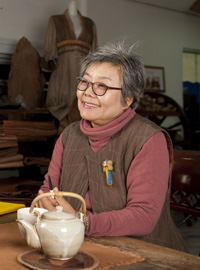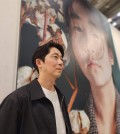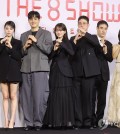- California Assembly OKs highest minimum wage in nation
- S. Korea unveils first graphic cigarette warnings
- US joins with South Korea, Japan in bid to deter North Korea
- LPGA golfer Chun In-gee finally back in action
- S. Korea won’t be top seed in final World Cup qualification round
- US men’s soccer misses 2nd straight Olympics
- US back on track in qualifying with 4-0 win over Guatemala
- High-intensity workout injuries spawn cottage industry
- CDC expands range of Zika mosquitoes into parts of Northeast
- Who knew? ‘The Walking Dead’ is helping families connect
‘Gal-ot’ master enriches traditional fashion
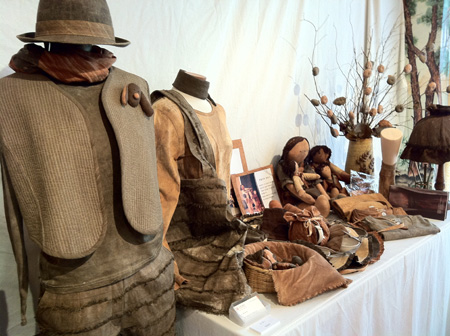
A hand-made collection of garments and handcrafts made from Gal-cloth, a white cotton cloth colored with persimmon extract, is on display at master Yang Soon-ja’s studio on Jeju.
By Lee Kyung-min
Yang Soon-ja, a dyeing master, believes people find happiness in doing what they want. “Enriching emotional experience is the truest way to make you happy. So far, it’s what has made me so,” said Yang, 64, who was listed on the World Masters Committee’s list Nov. 11. The CEO of the Jeju-based clothing and bedding manufacturing company Mongsengee made the list because of her distinctive expertise and dedication to the production of persimmon-extract-dyes and “Gal-ot,” the clothes made through the process.
In 2005, she won the best award presented by the Korea Federation of Handicrafts Cooperatives. The following year, she was listed as a Korean master by the Korea Masters Association. For her, maintaining an all hand-made principle is grueling and punishing at times, but the results are all the more rewarding. On an island of rocks, cultivating land into an 18,182 square-meter persimmon tree farm was in itself heavy labor.
“To make the clothes I want, doing everything by my hand was the first principle I wanted to stick to from the start to the end. It was never easy. That’s why I was so hesitant to start this business in the first place. But once I make a decision, I stick to it.”
Indeed, making the fabric for Gal-ot is a laborious and time-consuming process. A 9.5-meter-long and 1.1-meter-wide piece of cloth needs to go through the process of being soaked in persimmon extract and dried repeatedly, at least 10 to 15 times. And one piece of cloth goes through the process for 10 – 15 days.
Weather permitting, of course, because sunlight is an integral part of the chemical process. An ingredient called Tannin in persimmon plays a role here. It is a plantpolyphenoliccompound that binds to andprecipitates proteins and also works as a pesticide.
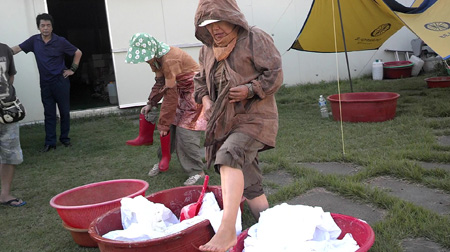
Women soak a pile of cloth in persimmon extract by stepping on it. The process is used to color the cloth evenly.
Gal-ot is an antibiotic, it stays in shape even when wet, doesn’t stain or smell easily. It has no artificial chemicals, so it’s popular among atopic dermatitis patients. That is why it has been worn by the locals as work clothing for hundreds of years.
But today, for that function precisely, Gal-ot and Gal cloth is gaining recognition as a healthy and organic alternative to synthetic products. And the recognition is mostly coming from outside the country, in Europe and Japan.
Half of its sales of 100 million won last year came from overseas markets with the other half from the domestic market. “Unlike other materials, using a washing machine doesn’t wear off, but strengthens the Gal-cloth. The mature and ripen color becomes all the more natural after washing, which Europeans love,” Yang explained.
Her story begins from childhood, a lively high-school girl who was a fearless cheerleader leading a crowd of 1,500 students. Always having been an art-enthusiast, she says she feels natural when it comes to art and having fun. That spirit drove her to pursue her dream to the point of taking the risk of going alone to New York, the city of fashion.
“My father wanted me to be a teacher, but I knew I always wanted to be in the fashion business. With a desire to make my clothes myself, I had four years of intern experiences at the United Nations Korea offices, so I wasn’t afraid of English. After graduating from Jeju Girls High School, I decided to go to New York. I stayed there from 1976 to 1988.”
She attended the Fashion Institute of Technology (FIT) during her stay, and returned to Korea and had her own shop in Bangbae-dong in southern Seoul. But in the back of her mind, there always was a “calling” to do something related to her home of Jeju. That was almost a sense of duty to her, strengthened by her overseas experience when Korea was a country barely known to foreigners.
“I’ve been thinking about my role to create something that could be proudly presented to foreigners. When I go back and forth from New York to Korea, there was nothing I could give my acquaintances as a present, except for dolhareubang — a stone sculptured to the shape of an old man. Most people rarely knew about Korea at that time, and I needed something unique that could represent Korea. And Jeju’s Gal-ot was it.”
Thus, her agriculture-like work was set in motion, and so did her happiness.
“If you like what you do, you never feel like it’s a waste of time or energy. Physically it really is demanding, but your heart is filled with happiness every day. I have a daughter myself, but I can’t ask her to take the business as I know it is so hard.”Even with the stress regarding the future of the business as one concern, she said she feels blessed having a job about which she feels passionate. “Of course I feel stressed. People need stress. How else would they lead or improve their life? You shouldn’t be complacent, or idle.”
Once a bubbly girl, whose friends were the green fields and the sea around Jeju, she wishes one thing for people who wear her clothes; to re-connect with their emotions.
“Nature was my friend: the wind, the grass, the sea breeze. I think my inspiration comes from those memories. I felt so happy then. If people, too, can be, because of my clothes, what more could I ask for?”







